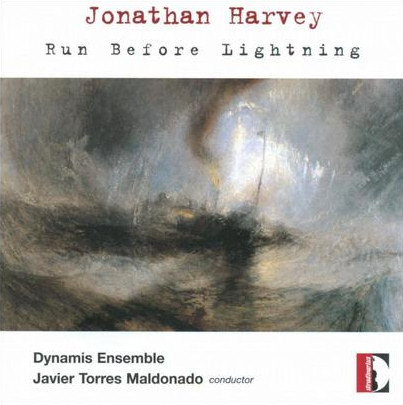Jonathan Harvey – Run before lightning

|
Un papier pour saluer la mémoire de ce compositeur anglais né en 1939 et décédé le 4 décembre dernier. On ne le connaissait que via sa pièce électronique Mortuos plango, vivos voco, relativement célèbre du fait d’une vraie jouissance de timbres due à une voix d’enfant et à la grande cloche ténor de Westminster : |
A paper to greet the memory of this English composer born in 1939 and deceased last December 4. We knew him only via his electronic work Mortuos plango, vivos voco, relatively famous because of a true pleasure of sounds due to a child’s voice and the large tenor bell of Westminster: |
 |
|
|
Cette pièce était d’ailleurs de facture spectrale : si Jonathan Harvey travailla à l’IRCAM, il se déclarait redevable également du courant spectral, inspiré par Giacinto Scelsi, et représenté principalement par Tristan Murail et Gérard Grisey. À ce propos, on ne met sur ce blog en général que des choses qui ont suscité notre intérêt – donc pas de papier sur Gérard Grisey, dont la musique nous est très étrangère, paraît datée, quand à son livre d’interviews, c’est bien trop abscons pour nous…. Revenons au CD du Dynamis ensemble (ensemble italien – avec notamment une excellente pianiste : Candida Felici). Run before lightning de 2004 pour flûte et piano est une œuvre très plaisante, du fait sans doute de l’instrument employé. Supposée décrire un rêve du compositeur d’une tempête à la fois exaltante et terrifiante, il faut bien avouer, que même avec tout l’attirail des modes de jeu modernes, on a quand plutôt l’impression d’une pastorale, un peu répétitive… Vers (2000) pour piano, écrite pour les 75 ans de Pierre Boulez est une œuvre assez brillante, très imagée. Curieusement ça sonne moins ‘moderne’ que même du Messiaen. Quantumplation (1975) est d’inspiration sérielle, le tam-tam figurerait l’atome autour duquel tournent les autres instruments dans cette pièce inspirée d’après l’auteur par la théorie des quantums. Cette pièce est un peu monotone et semble effectivement tourner en rond… Flight-Elegy (1989) pour violon et piano et Natajara (1983) pour flûte et piano sont liées à l’Extrême-Orient. La 1e, dédiée à un violoniste du BBC Scottish symphony mort en pilotant un avion expose le violon dans une sorte de thrène dans l’extrême aigu avant une « catastrophe » d’accords rageurs. Bravo à la violoniste -Dominique Chiarappa-Zryd, pour rendre avec tant de « justesse » cette partition souvent micro-tonale et très prenante. Natajara (Shiva en danseuse) est plus animée, avec une innovation absolue : le (la) pianiste claque la langue pour accompagner certains accents de la flûte… Tombeau de Messiaen (1994) pour piano et bande sur laquelle douze pianos ont été enregistrés… d’après Harvey « un va-et-vient entre fusion spectrale et polyphonie micro-tonale ». Cela donne parfois quand-même l’impression d’un vieux piano désaccordé. The Riot (1993) est pour flûte, clarinette basse et piano. Pour la petit histoire, c’est l’anagramme du dédicataire, le Het trio ; c’est une œuvre intéressante… Le CD se termine par un Haiku pour piano de 0’24 ». Bref, au travers de ces quelques morceaux, on distingue une œuvre sinon forte, du moins attachante et inventive. |
This work was rather of spectral inspiration: if Jonathan Harvey worked at the IRCAM, he also declared his debt to the spectral movement, inspired by Giacinto Scelsi, and represented mainly by Tristan Murail and Gérard Grisey. On this subject, we put in general on this blog only things which aroused our interest – thus not paper on Gerard Grisey, whose music is very foreign for us, appears dated. Let us return with this CD by the Dynamis ensemble (Italian – with in particular an excellent pianist: Candida Felici). Run before lightning of 2004 for flute and piano is a very pleasant work. Supposed to describe a dream of the composer of a storm at the same time exciting and terrifying, even using all the modern playing modes, this piece dounds pastoral, and a little bit repetitive… Vers (2000) for piano, written for the Pierre Boulez 75th anniversary is a rather brilliant work, very picturesque. Curiously that sounds less “modern” than even Messiaen. Quantumplation (1975) is of serial inspiration, the tom-tom would appear the atom around which the other instruments turn around according to the author’s mention of the theory of quantums. This part is a little monotonous and seems indeed to turn in round… Flight-Elegy (1989) for violin and piano and Natajara (1983) for flute and piano are related to the Far East. The 1st , dedicated to a violonist of the BBC Scottish symphony who died flying a plane exposes the violin in a kind of threne in the acute extreme before a “catastrophe”. Bravo to the violonist – Domenica Chiarappa-Zryd, to return with such an “accuracy” this often micro-tonal and very fascinating partition. Natajara (Shiva as a dancer) is animated, with an absolute innovation: the pianist snap her tongue to accompany certain accents by the flute… Tombeau de Messiaen (1994) for piano and band on which twelve pianos were recorded… according to Harvey “comings and goings between spectral fusion and microphone-tonal polyphony”. That sometimes anyway gives the impression of an old out-of-tune piano. The Riot (1993) is for flute, low clarinet and piano. Anagram of the dedicatee, Het trio; it is an interesting work… CD ends with a Haiku for piano of 0’24 ». In short, through these few pieces, we can distinguish, if not a very strong one, an attaching and inventive work. |
